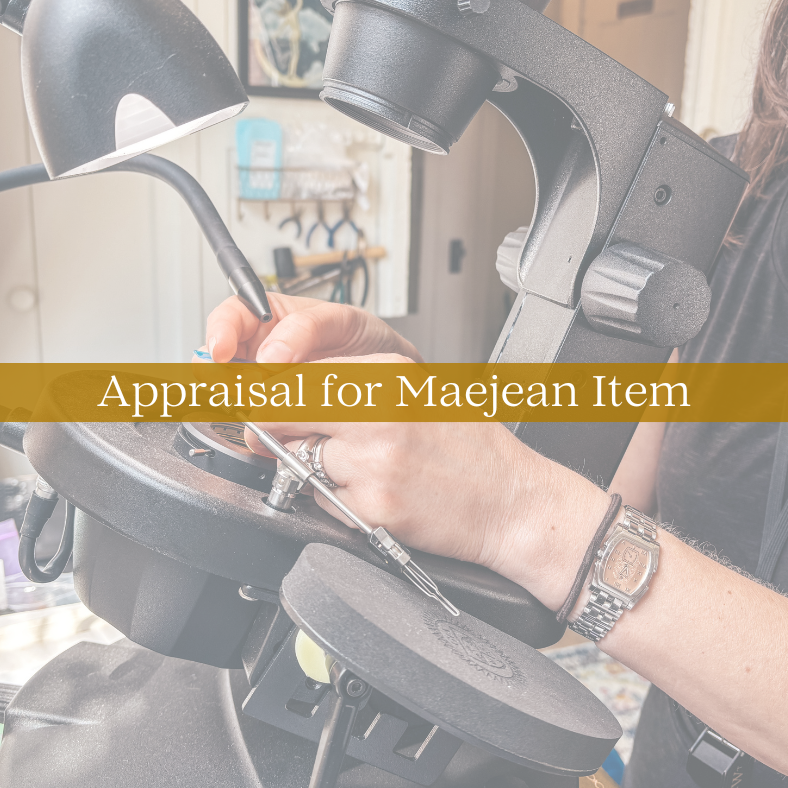Jewelry collecting can quickly turn from a casual new hobby to a lifetime journey. Love a variety of jewelry eras and don't know where to start? Start by collecting the basics from each era, and see which ones stand out the most to you! Let's take a look at some of the most popular motifs, metals, gemstones, and styles from some of our favorite eras to collect from, starting in the Victorian era up through the 1970s.
Note that in this guide, we only mention a handful of styles and motifs that we see and have available in our shop the most often!
Victorian Era (1837-1901) Essentials

An unforgettable staple of the Victorian era, mourning jewelry became popular following the death of Prince Albert, when Queen Victorian went into a long period of mourning. Certain materials and styles were staples among regular citizens. Though mourning jewelry can mean a variety of things, there are certain kinds that are considered especially collectable.
Jet, an organic gem that is a form of coal, was a common material used to make pendants and other jewelry. Its black color made it a common choice for mourning jewelry in the Victorian era.

Perhaps the most infamous kind of Victorian jewelry is known as hair jewelry. Locks of hair were preserved in brooches, rings, lockets, and other jewelry as mementos to remember special loved ones, whether as a simple token to cherish a living lover or as a preserved memory of a loved one who had passed. Hair jewelry is rarely made today, which makes Victorian hair jewelry so special and collectable!

Edwardian Era (1900-1910) Essentials

Though stick pins were invented before the Edwardian era, it was one of the last eras where they were really appreciated. Used by both men and women to fasten clothing like ties, cravats, hats, and other clothing, ornamental stick pins were both functional and stylish until close to World War I. Practical use of stick pins died away with the mass production of zippers and buttons.

Also called slide chains or pocket watch chains, lorgnette chains were especially popular in the late 1800s and early 1900s. They often have decorative sliding charms on them and swivel clips on the ends to attach to a pocket watch or opera glasses. This made it easy to wear these items around the neck, pinned to a dress, or retrieved from a pocket or waistband.

Dainty lavalier pendants, necklaces that often have a jewel or two dangling from the end, are essential for the Edwardian look.

The namesake for the Edwardian era, King Edward VII, was a big fan of equestrian sports, which is evident in the popularity of horse and equestrian motifs during this decade.

An art movement that inspired everything from clothing, to architecture, to jewelry, Art Nouveau is a style characterized by flowing lines and nature. Popular Art Nouveau style motifs include florals and ethereal-looking female figures.

Celestial designs are another motif that was a hit in the 1800s stretching into the early 1900s. Crescent moons have been said to represent the feminine moon goddess and female empowerment, giving these designs great meaning during the fight for women's right's in the beginning of the 20th century. Stars, a symbol of guidance, are often paired with moons in celestial jewelry and give a symbol to the phrase "I love you to the moon and back."
Art Deco Era (1920-1939) Essentials

Invented at the end of the 1910s just in time to take over the Art Deco era was white gold. Before the 1920s, silver or platinum were used if a piece was to include a white metal, but when white gold alloys were created using extra metals like nickel or zinc, yellow gold was out and white was in.

The Art Deco era is defined by geometric designs in architecture, decor, and of course, jewelry. Hard lines and geometric motifs are a staple of this decade, and one of our favorite examples is the geometric ring head design of many diamond rings from the era!

They don't make filigree and open metalwork like they used to! While also popular even earlier in the 20th century, open metalwork when combined with the brand new invention of white gold became an unstoppable pair in the Art Deco era.

Providing ample finger coverage, filigree shield rings are another iconic Art Deco staple to add to your collection!
Retro 1940s Era (1940-1949) Essentials

Perhaps one of the most classic motifs in the 1940s era were heart motifs. Due to World War II, heart jewelry was an incredibly symbolic gift for soldiers to give their sweethearts before leaving for war. This was especially evident in the popular heart shaped lockets that many owned in the 1940s.


Another iconic design that started becoming popular in the 1940s is the illusion style ring head. Illusion style rings allowed smaller diamonds to look bigger by setting a diamond in a square setting made of white metal. Many of these rings feature white metal at the ring head and sometimes on the shoulders, but have a yellow gold band, making the piece two-tone. Two-tone diamond rings from the 1940s are almost instantly recognizable with these classic features!

Add some color to your 1940s jewelry stash with colored gemstone cocktail rings!

Rose gold made a comeback in the 1940s as it was common to make two-tone yellow and rose gold pieces.
Mid Century 1950s Era (1950-1959) Essentials

With the end of the war and the lifting of the ban on platinum for use in jewelry, the 1950s saw a return to white metals as the preferred jewelry metal. White diamonds on white metals were a common way to make a statement. Swirly, asymmetrical patterns were also abundant in Mid Century rings, giving each piece a unique show-stopping quality to show off at parties.
Retro 1960-70s Era (1960-1979) Essentials

Created star sapphire rings were found in abundance in the 1960s. Star sapphires display beautiful rayed stars (called "asterisms") that shine bright in direct sunlight and move across the gem when tilted and viewed from different angles. Though first invented near the end of the 40s, the 1950s and the 1960s gave us most of the vintage pieces we find today.

With the traveling exhibition of Tutankhamun's treasures in the 1960s came a revival in Egyptian-inspired jewelry, particularly scarab jewelry like bracelets and necklaces. These colorful pieces feature carved scarabs made from gemstones like carnelian, unakite, rhodonite, chalcedony, tiger's eye, and more.

It should be no surprise that quirky colors like coral, turquoise, and other bold and bright hues are found coloring many pieces of jewelry from the 1960s. Emerging freedoms and challenges against the norm brought with them experimentation with both color and design!

Mano figa pendants are so rich in feminist symbolism that it's no surprise that these were popular in the 1960s and 70s. These gestured hand symbols are an ancient slang term for female anatomy, and have been used to represent a variety of things in different cultures throughout the years. Representing things like good luck, protection against evil, fertility, and femininity, it's clear why the feminist movements of the 60s and 70s found a use for these symbolic pieces of jewelry.

Brutalism was an architectural style popular from around the 1950s to the 1970s that made its way to jewelry. The out-of-this-world geometric designs in brutalist style jewelry are just one example of some of the bold styles found in 1970s pieces.

Inspired to start collecting jewelry from all of these eras? Tell us what you want to collect first!




